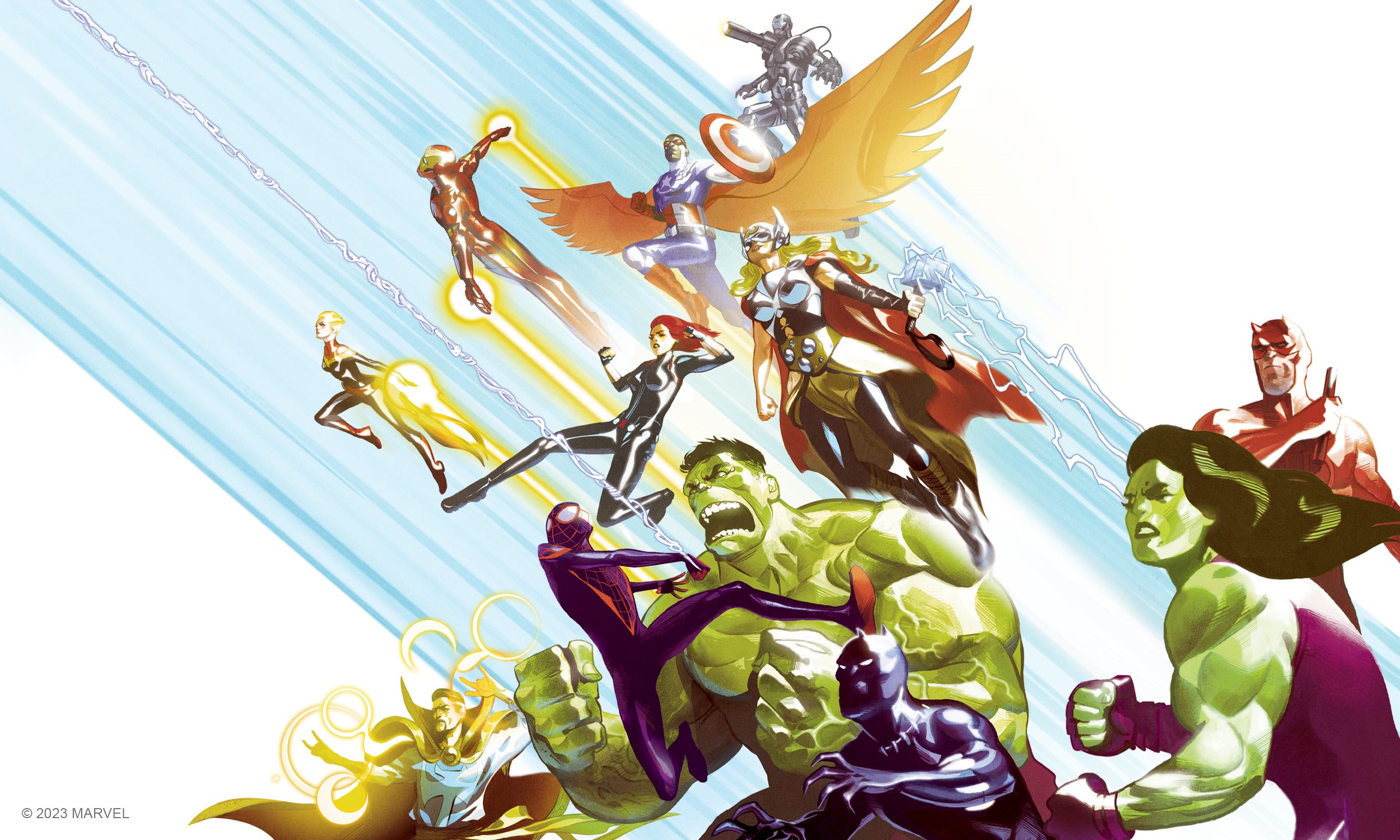-
- Certains services ne sont pas accessibles avec un téléphone
- Ouvrir une session
- Mon compte
- Service à la clientèle
-
Produits
- Featured At Canada Plays
-
Précommandes
Précommandes
- Précommandes en vedette
- Toutes les Précommandes
- 2024 - Week 16 (Apr. 15)
- 2024 - Week 15 (Apr. 8)
- 2024 - Week 14 (Apr. 1)
- 2024 - Week 13 (Mar. 25)
- 2024 - Week 12 (Mar. 18)
- 2024 - Week 11 (Mar. 11)
- 2024 - Week 10 (Mar. 4)
- 2024 - Week 9 (Feb. 26)
- 2024 - Week 8 (Feb. 19)
- 2024 - Week 7 (Feb. 12)
- 2024 - Week 6 (Feb. 5)
- 2024 - Week 5 (Jan. 29)
- 2024 - Week 4 (Jan. 22)
- 2024 - Week 3 (Jan. 15)
- Nouveautés
- Fantasy Flight
- Boardgames
- Miniatures
- Collectible Card Games
- Books
- Dés
- Puzzles
- Roleplaying Games
- Supplies
- Decor
- Toys
- Plushies
- Clearance
- All
- Maison Édition
- Nouveautés
- Précommandes
- Spéciaux Magic
- Clearance
- Contactez Nous
- QFP
- Demande Application
D.A.G.G.E.R.
Article written by FFG and reproduced here with permission - March 31, 2023
Cet article est uniquement disponible en anglais.
A First Look at FFG’s Newest Marvel Board Game
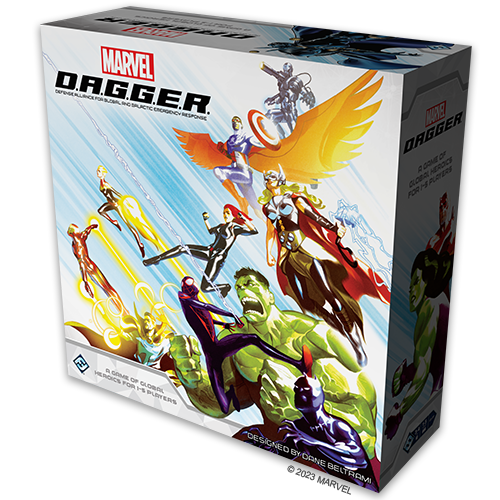
Mission start.
Earth is in danger. Nefarious forces threaten the world as we know it, and only a small team of heroes can come to its rescue. With the enemy’s minions closing in and innocents in peril, those heroes must work together to stop the villain’s plans and save the world. But can they do it in time?
Fantasy Flight Games is proud to present Marvel D.A.G.G.E.R., a brand-new cooperative board game featuring iconic heroes and villains from Marvel comics!
In this game for one to five players, you’ll jump into the role of one of 20 heroes and race across the globe to complete missions, battle enemies, and square off for the final showdown against the nemesis. Wield the power of different heroic aspects to match your ideal playstyle, then pull off strategic combos with your fellow heroes and wait for the perfect moment to unleash your ultimate ability. Team up with your allies and take on global threats from some of Marvel’s most dangerous villains!
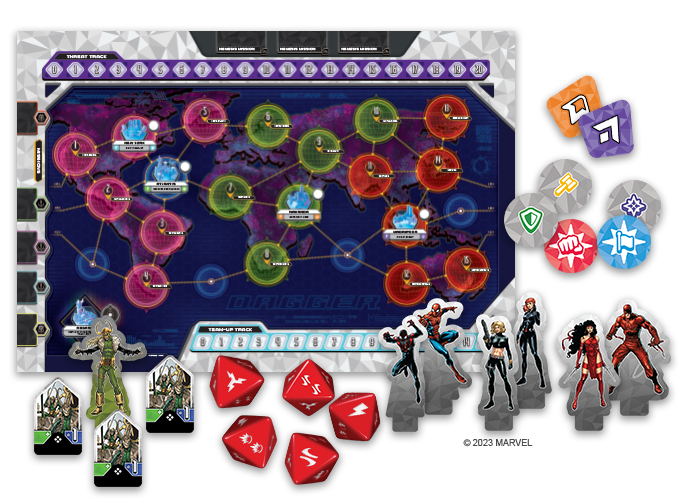
Assembling the Team
In this game, “D.A.G.G.E.R.” stands for “Defense Alliance for Global and Galactic Emergency Response,” and the “Alliance” and “Emergency Response” parts are the driving force behind how the game is played. The focus of the game is on using teamwork with your fellow heroes to resolve crises around the world and strengthen yourselves in time to take on the nemesis.
And what’s the best way to work together in a game like this? One word: combos!

The team-up track and combo tokens.
There are two types of combo tokens: empowered tokens and primed tokens. When a hero becomes “empowered,” they can later discard their empowered token to add one success to any attribute test they perform (spoiler alert: you’ll be performing a lot of those tests). When an enemy is “primed,” a hero attacking that enemy can remove a primed token from them to add one success to the attack result (which means more damage dealt).
Not bad, right? But those are just the most basic uses for these tokens, and it turns out the heroes can do a lot more!
Each hero has at least one “combo ability” that requires either an empowered token on themself or a primed token on an enemy to trigger. Triggering these combo abilities comes with an extra benefit: advancing the team-up track. The team-up track is a resource shared by all heroes and is used to pay for “team-up abilities,” the strongest abilities in each hero’s arsenal (more on those later).

These are just 6 of the 20 heroes you can choose from.
Speaking of heroes, there are 20 to choose from, split into 10 pairs represented by double-sided hero sheets. Each hero in a pair has similar powers and/or deep ties to one another, but even if their powers are similar, their playstyles can be very different!

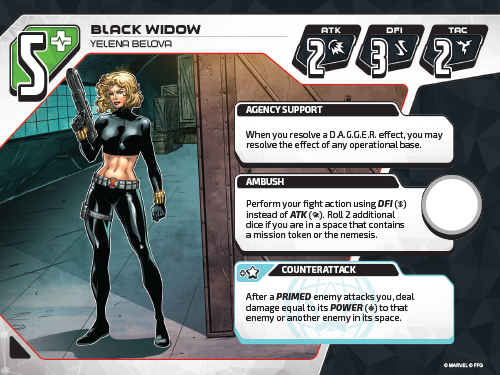
For example, the hero Black Widow (Natasha Romanoff) has several tactical abilities that can greatly accelerate the heroes’ action economy. Her Quinjet ability lets any hero move three spaces, and her Martial Mastery combo ability lets her benefit from a primed token on an enemy while leaving that enemy primed for another hero afterwards. Meanwhile, Black Widow (Yelena Belova) focuses more on offense. Her Ambush ability lets her use her “defiance” stat to fight instead of her attack power and grants her bonus dice under certain conditions, while the Counterattack combo ability lets her deal heavy damage in response to a primed enemy attacking her. Both heroes use the name “Black Widow,” but each of them operates in a very different way!
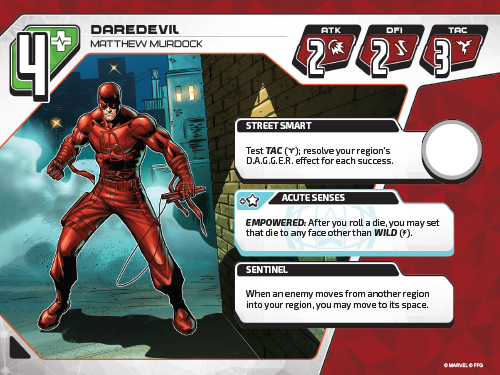
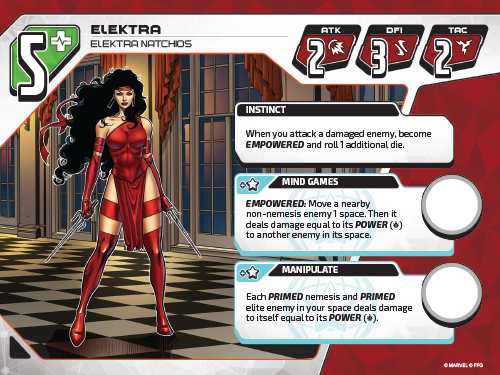
In a similar vein, we have the heroes Daredevil and Elektra. While they do not share a hero name, they are nevertheless a closely related pair, and yet once again they play differently from one another. Daredevil is a specialist that focuses on control and response, using his Sentinel ability to intercept enemies and utilizing the combo ability Acute Senses to ensure he succeeds in critical moments. Meanwhile, Elektra functions as a self-sufficient damage dealer who can empower herself with Instinct and use her two combo abilities, Mind Games and Manipulate, to get enemies to damage themselves and each other.
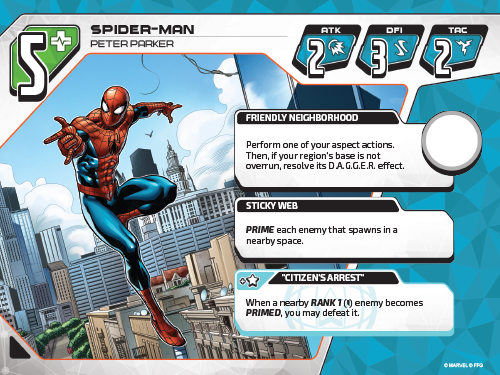 .
. 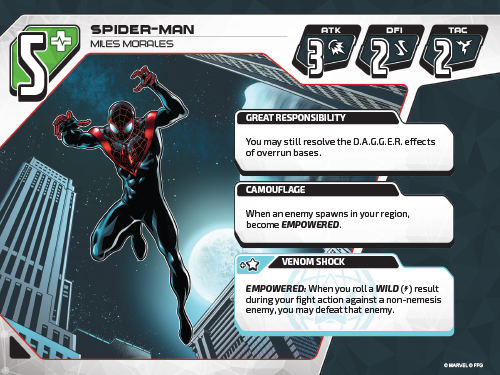
If the heroes have such different playstyles from each other, then why are they in pairs? The answer to that is twofold: strategy and support! Each hero begins the game with two support cards unlocked, which they share with their “partner hero” on the other side of their sheet. For example, both Spider-Man (Peter Parker) and Spider-Man (Miles Morales) start the game with the Spider-Sense and Web-Shooter supports in play. How each Spider-Man uses these supports will vary depending on which one you’re playing as, but you’ll always have them whenever you play a Spider-Man.
That said, each hero also has a unique support specific to them that must be unlocked during the game. These unique supports can normally only be used when playing their associated hero; this means that only Spider-Man (Peter Parker) can use the Aunt May support, while only Spider-Man (Miles Morales) can use The Champions under normal circumstances.

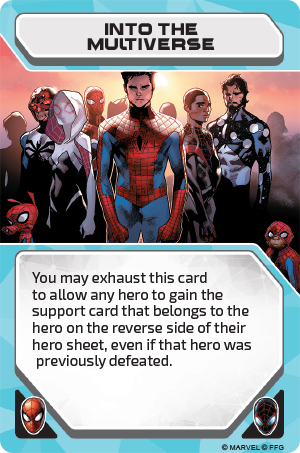
Before we move on from heroes, there is one more thing that we should cover. Remember those team-up abilities we mentioned earlier? These take the form of a special card that, similar to the non-unique supports, is shared by both heroes in a pair. You gain access to your team-up ability by spending enough charges from the team-up track to flip it to its “active” side. When you’re ready to use it, you can “exhaust” the card (flip it back to its inactive side) to trigger its effect. As we said before, the team-up abilities are powerful effects that can alter the course of the whole game; for example, the Spider-Man team-up ability Into the Multiverse allows any hero to instantly gain the unique support belonging to their partner hero (something you normally can’t do), without the need to unlock it first!
Aspects of Heroism
The heroes provide plenty of strategic depth all on their own, but there is another choice you must make when deciding who you want to play as: the choice of heroic aspect.
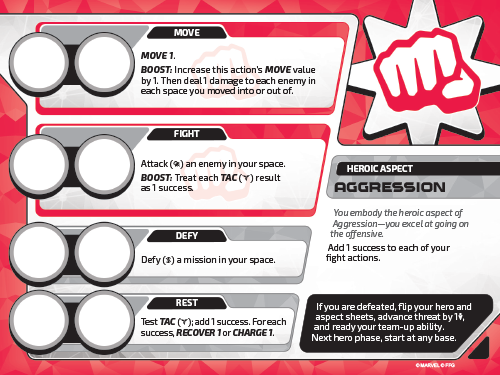
There are six aspects to choose from, and each gives you access to the same basic actions: move, fight, defy, and rest. We won’t go into detail about the ins and outs of actions today, but you will notice that each aspect has certain benefits for certain actions. For example, the Aggression aspect allows you to deal a bit of damage after moving, and it also strengthens your fight actions (obviously) by giving you additional successes.
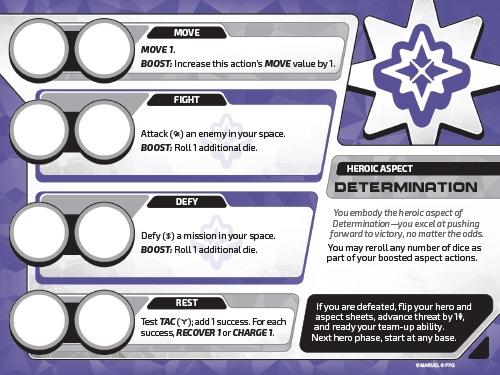
Meanwhile, the Determination aspect focuses on succeeding in the face of overwhelming odds. Your fight and defy actions can be boosted to roll additional dice, and you can even reroll dice to increase your chances of succeeding a crucial test.
Each aspect has a different focus, and that focus can shape your playstyle almost as much as your chosen hero. With 20 heroes and six aspects, that’s 120 different combinations to experiment with, which means you’ll have lots to come back to after your first game!
A Global Threat
With all these tools at their disposal, the heroes in Marvel D.A.G.G.E.R. must be up against some truly challenging threats, right? Enter: the nemesis.
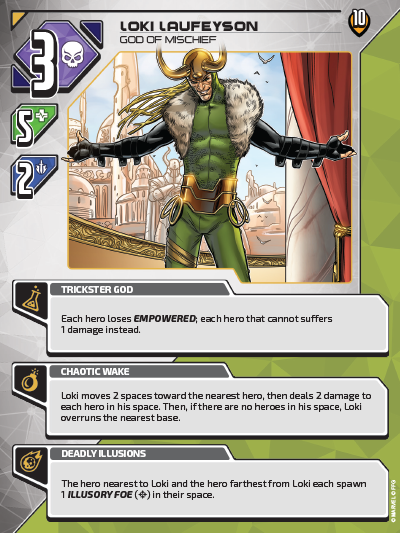
Just like how you and your fellow heroes will be racing around the globe to solve crises (called “missions” in-game), the nemesis will be traveling around the world to cause them! And while you can attack the nemesis at any time, you can’t actually stop them until the final showdown. The best you can do until then is stall them and stop them from achieving their goals.
Each nemesis has different ways to cause trouble for the heroes. For example, Loki Laufeyson can trick heroes out of their empowered status and ambush them with Illusory Foes. Each nemesis has their own signature minion (Loki’s being the aforementioned Illusory Foe), but they’ll also be accompanied by a group of enemies that can vary from game to game. Having Loki team up with Frost Giants may be thematic, but what if he commanded some Hydra Soldiers instead?
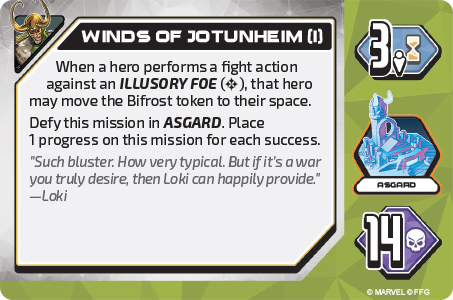
In addition to side missions that can emerge as you play—such as Simmering Unrest and Spreading Chaos—heroes will need to complete the nemesis’s unique missions in order to reach the final showdown. Each nemesis mission has two outcomes: success or failure. If the heroes succeed in completing the mission, they weaken the nemesis, making the final showdown a little easier. However, if they fail, then the nemesis gets powered up during the final fight. Once all three nemesis missions are complete, the final showdown begins!
There are four different nemeses to face in Marvel D.A.G.G.E.R. We’ll go into more detail on who the other three are—as well as what the final showdown entails—on a later date, so stay tuned!
Saving the World, One Neighborhood at a Time
With tons of replayability and an all-star cast of some of Marvel’s greatest heroes, Marvel D.A.G.G.E.R. is a thrilling game of teamwork, action, and strategy. Look forward to more information on this game in the coming months.
Do you think you have what it takes to save the world? Find out when Marvel D.A.G.G.E.R. releases in June!

